Global Market Comments
March 15, 2019
Fiat Lux
Featured Trade:
(BUY JOHNSON & JOHNSON ON THE BAD NEWS),
(JNJ), ($INDU), (PFE), (NVS), (AZN)

Global Market Comments
March 15, 2019
Fiat Lux
Featured Trade:
(BUY JOHNSON & JOHNSON ON THE BAD NEWS),
(JNJ), ($INDU), (PFE), (NVS), (AZN)

When one of the 30 Dow Average companies ($INDU) gets into trouble, I sit up and take note, stand to attention and drill down with a magnifying glass.
After all, it may have a major important on an important tradable index, thus opening up an investment opportunity. It also may sound the alarm for a great single stock pick. That is certainly the case with New Brunswick, NJ based Johnson & Johnson, one of the oldest companies traded on the NYSE.
What piqued my interest today was the news that the company lost another talcum power lawsuit, which is alleged by plaintiffs to contain asbestos. This has been among the catalog of urban conspiracies for decades now.
Johnson & Johnson (JNJ) is, in fact, carrying on with their mission to strengthen their pharma sector which has consistently served as their top revenue driver in the past years. While their strong performance in this segment has always been led by their oncology portfolio, with sales of their cancer drugs increasing by 22.1% worldwide in the previous quarter, it looks like more and more products are on their way to becoming JNJ's blockbuster items.
The company estimates to launch more than ten new drugs -- all of which have the potential to be blockbuster products -- by 2021. On top of these, JNJ expects to complete 50 line extensions on their existing products. Both efforts are anticipated to temper the effects of generic drugs that are threatening to hamper the sales of a lot of key products in JNJ's portfolio.
The latest potential blockbuster drug for JNJ is Esketamine which is an anti-depressant aimed at treatment-resistant patients. This was developed by the company’s pharmaceutical arm, Janssen Pharmaceuticals Inc. This new groundbreaking product was approved on March 5 by the FDA and will be marketed as Spravato. It is hailed as the first prescription depression drug developed from ketamine, which is more commonly used as an anesthetic.
Although ketamine has long been tagged as a party drug, aka “Special K”, and is approved as an anesthetic, no company has patented its use. This is where Janssen swooped in and patented the left section of the molecule, called esketamine, and sent their application to FDA. The approval of this drug, which FDA described as a “breakthrough therapy” thus receiving priority review, translates to a potential cash cow for JNJ as it successfully legitimized the application of ketamine as an anti-depression drug.
Aside from depression, FDA is also taking into consideration the applicability of esketamine to patients afflicted with mood disorders such as bipolar disorder. The organization looks at it as a potential solution for reducing suicides as well.
Other drugs projected to rake in massive sales for JNJ pipeline include psoriatic arthritis Tremfya, prostate cancer medication Erleada, and metastatic urothelial cancer treatment Erdafitinib. With the addition of Spravato on the list, sales are expected to reach more than $1 billion.
However, no company is perfect and the same goes for products -- even if they are poised to become blockbuster drugs. A major hindrance for the success of Spravato is cost.
Here's a sample quote for potential patients.
A one-month initial treatment will cost somewhere from $4,000 to $7,000. The exact price will depend on the dosage and if it's availed wholesale. Expenses for follow-up treatments will reach $2,360 to $3,500 a month. All in all, Spravato could become as expensive as an electroconvulsive treatment or even a transcranial magnetic stimulation therapy. Worse, this treatment might have to be shouldered by the patients themselves.
Another deterrent for investors looking into JNJ is the continuing issue concerning the talcum powder lawsuits which claim that the talc items of the company contain asbestos that resulted in ovarian cancer among many of its female users. As of August 2018, a Missouri court has ordered JNJ to pay 22 women a total of $4.7 billion for damages. While the company announced its decision to appeal the ruling, the case has been a huge red flag for investors ever since.
Nonetheless, it appears that JNJ remains a solid stock for a lot of investors.
With an annual revenue of $81.6 billion, (JNJ) is anticipated to stay ahead of its competitors Pfizer (PFE) ($53.4B), Novartis (NVS) ($51B), and AstraZeneca (AZN) ($21.9B). Taking into consideration currency impact, which is expected to negatively affect sales by roughly 1.5%, JNJ's revenues are projected to hit $80.4 to $81.2 billion this year.
While it still has a long way to go, the recent approval of Spravato spelled higher confidence in JNJ's revenue growth this year. The company's purchase of robotic surgical instruments manufacturer Auris Health, for $3.4 billion further strengthened its dominance in the industry.
In the past month alone, its shares rose by 4.55%. Investors are also anticipating more growth until the next earnings report, which is anticipated to show $2.10 earnings per share for the company. This represents a 1.49% year-over-year increase.
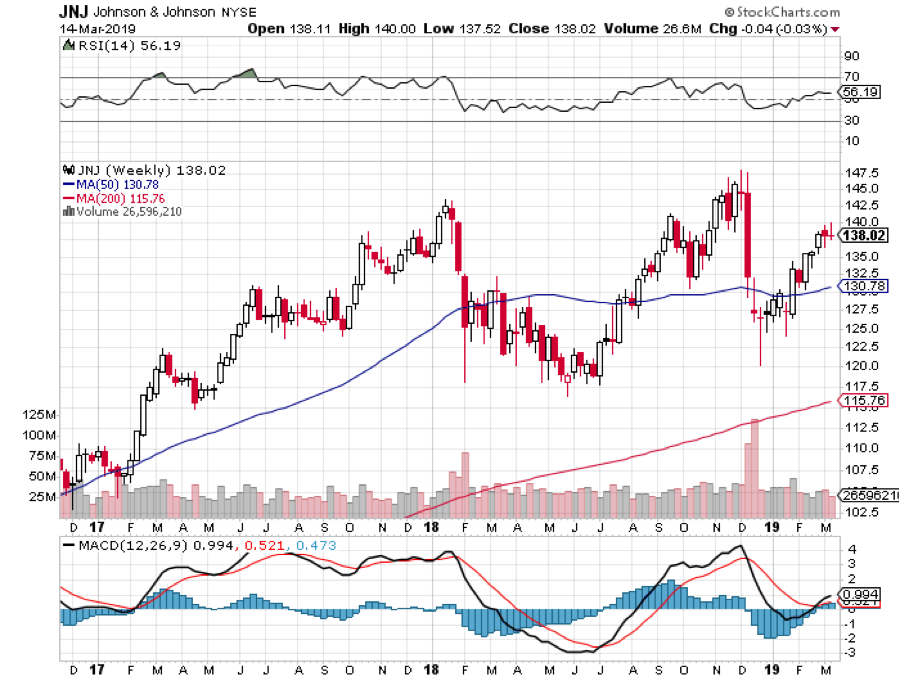
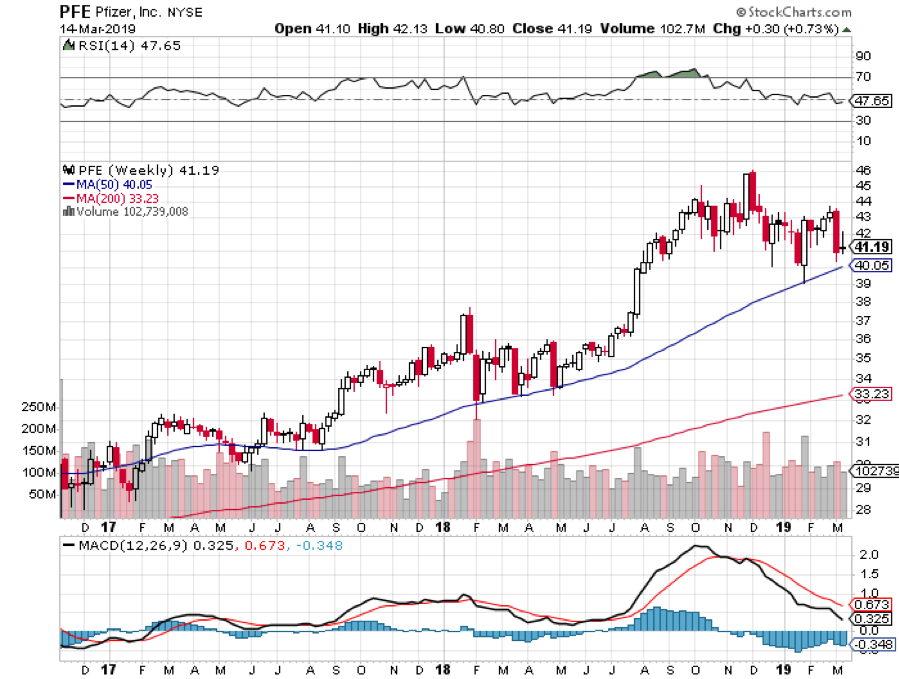
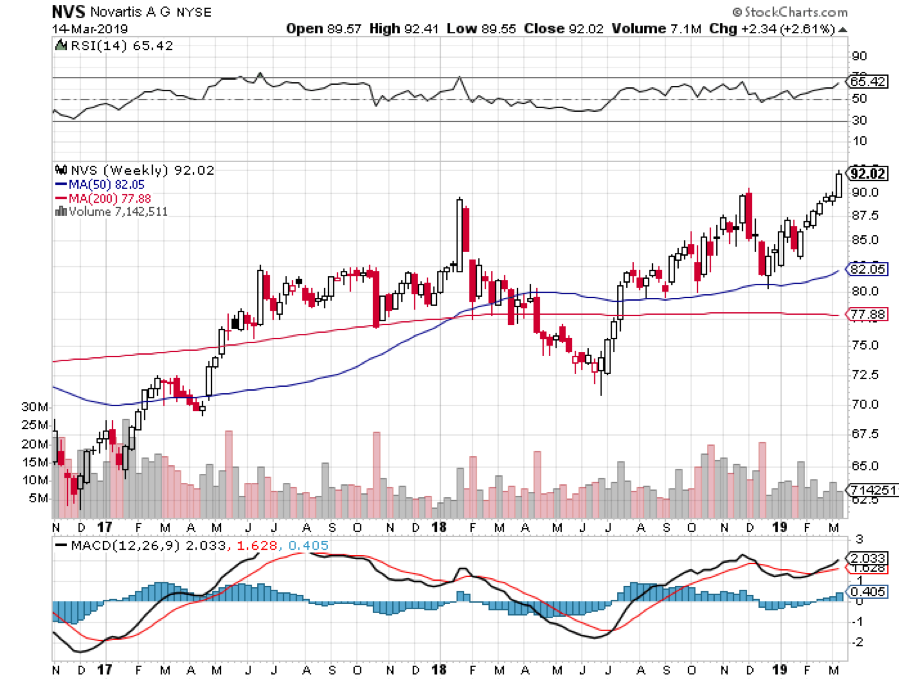
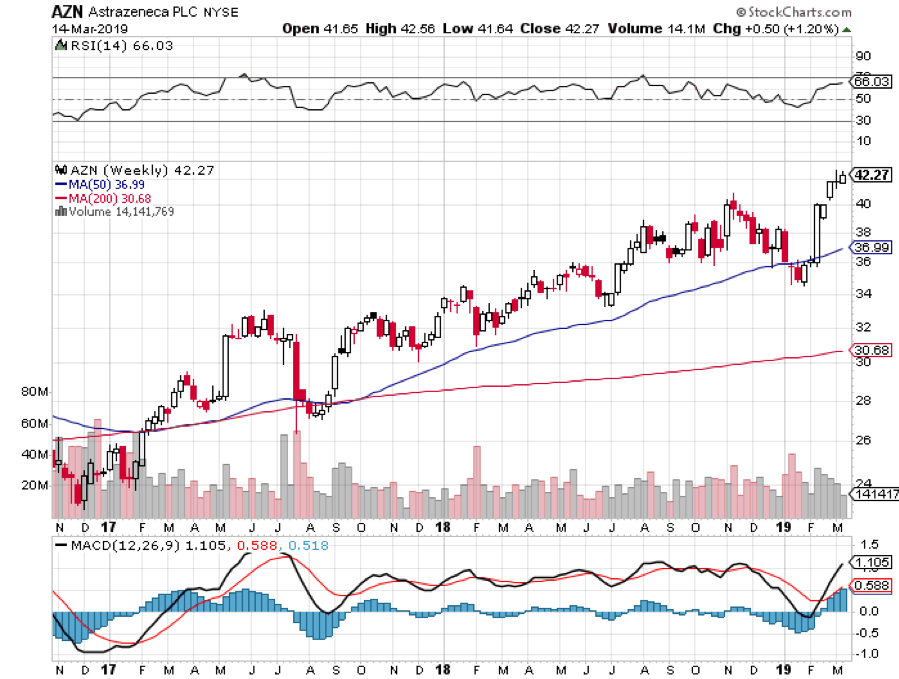

Mad Hedge Technology Letter
December 19, 2018
Fiat Lux
Featured Trade:
(HOW TECH IS EATING INTO HEALTHCARE COSTS)
(VEEV), (CRM), (GSK), (AZN), (MRK), (NVS), (DBX), (OKTA), (TWLO)

It’s undeniable that American healthcare costs are a big part of a family’s monthly expenses.
Rising deductibles and out-of-network fees are a few of the out-of-pocket costs that can singe a hole in the average joes’ pocket.
It was only in 2016 when healthcare insurance costs eclipsed more than $10,000 a year per person, and over the past 12 months, 68% of people surveyed admitted that future healthcare costs would probably consume a larger part of their earnings.
The result is that healthcare companies are making money hand over fist.
Is there something that I deduce from this lucrative part of the economy that has the potential to feed into the tech sector?
The tidal wave of money spilling into the healthcare industry has also given impetus to these firms hoping to buttress their networks and IT with modern tech infrastructure to take advantage of the efficiencies on offer.
Building the best cloud services geared towards specific industries has been a winning formula and the generated momentum will continue into the next calendar year.
Prime models can be seen all over the tech ecosphere and they will be big winners of 2019.
One example is Twilio (TWLO) who has quietly risen the bar for communication cloud products.
A panoply of small companies can now offer professionalized email, text message, automated voice mail services amongst other services that do the work of 100 employees.
Recently, I touched on a cloud company named Okta (OKTA) responsible for managing the facilitation of passwords.
This identity management company was formed by a group of former Salesforce executives.
In my book, a Salesforce (CRM) credential is a golden stamp of approval for newly formed cloud-companies seeking to develop new cloud products in broad industries.
Why?
Salesforce’s client relationship management platform (CRM) is ubiquitous and the most popular enterprise software.
The way they develop their model is by launching and acquiring new e-commerce and marketing services - which lure in customers into its walled gardens.
Salesforce also applies its artificial intelligence platform Einstein to harness customer relationships and help businesses carry out decisions based on data alone instead of testosterone and emotion.
This all means that Salesforce executives have their finger on the pulse of the cloud landscape and know how to build a cloud business from scratch which is valuable.
They know what certain industries require to mushroom and can deploy resources in the quickest way possible while surrounding themselves by hordes of software engineers who can be poached for a certain fee.
The framework being in place is a massive bounty for these executives who just line up the dots then motor on to an industry confirmed by the data.
And remember that 99.9% of people do not have access to this proprietary data.
Consequently, they know more about corporate America than most Fortune 500 CEOs.
Marrying up the healthcare industry to the cloud was just a matter of time.
Veeva Systems (VEEV) is a cloud-computing company focused on pharmaceutical and life sciences industry applications.
Founder and CEO of Veeva Systems Peter Gassner cut his teeth at Salesforce serving as Senior Vice President of Technology.
His job was building the salesforce.com platform including product, marketing and developer relations.
Gassner has effectively transplanted the Salesforce platform model and applied it to the life sciences industry and has done a great job doing it.
The Veeva Commercial Cloud includes a CRM platform that aids drug company’s management of clients.
The Veeva Vault is a tool that tracks industry regulations, clinical trials, and recommends actionable habits in the cloud.
Veeva's CRM platform is powered by the Salesforce1 app development platform and is integrated into the broader Salesforce Marketing and Service Clouds.
The first mover advantage has offered all the low-hanging fruit for Veeva.
The lack of competition surely never lasts but the extra time to pad their lead is only a positive to its business model.
Veeva has already lured in some of the health industries biggest names such as GlaxoSmithKline (GSK), AstraZeneca (AZN), Merck & Co. (MRK), and Novartis (NVS).
These heavy hitters are meaningfully tied to its ecosystem, and it is safe to say that these relationships are only scratching the surface and have the potential to expand as Veeva installs more add-on tools into its platform.
The popularity shows up in the numbers with Veeva’s 3-year sales growth rate hovering around 30%.
Even better, the profitability of Veeva is indicative of the strength in its business model. They are simply at the right place at the right time to capture the momentum from the digital crossover in the healthcare industry.
Many similar names like Dropbox (DBX) are enormous loss-making enterprises but Veeva has shrugged off this stereotype that many cloud companies of its size can’t be profitable.
The effect of being strategically placed in a position to cherry pick the lucrative healthcare industry has also seeped into the strong profit margins of Veeva able to grow it to over 32%.
Touching more on the profitability, EPS has kicked into gear sequentially rising 80%, and the long-term outperformance is backed up with a 3-year EPS growth rate of 41%.
This cloud company is incredibly profitable for its size, and part of that is the absence of competition which increases pricing power.
Dropbox does not have that luxury of favorable pricing schemes which cripple profitability and leads to attrition and just as harmful – a price war.
Veeva’s forecasts for next year blew past Wall Street’s estimates and the company is modeling for EPS of $1.58 and revenue around $856 million in 2019.
Gassner has even publicly acknowledged that he expects 2019 revenue to come in between $1 billion and $1.1 billion which is a full year ahead of schedule.
The bullish guidance is a clue that the overall cloud story is alive and kicking, and there is absolutely no weakness whatsoever.
Making this story even more compelling is that in the last five years, profits are up six-fold, revenue is up four-fold, and the number of new products is up three-fold.
As we advance into 2019, I believe Veeva is a buy-on-the-dip candidate because of its favorable market position, rapidly expanding margins, and its low enterprise value of $11 billion which deems it, as I daresay, a lucrative buyout target for larger industry cloud players like Salesforce.
The tech industry has a habit of coming full circle become of its network effect of capital, talent, and management.
I would be interested in dipping my toe into any of Salesforce’s offspring because these models are built to scale and are waiting on the doorstep to seize revenue from industry migrating to digital.
Okta did it, and Veeva Systems made the leap of faith too, confirming that the Salesforce method is a path to untold profits for cloud-based software companies.
When the market can finally digest the macro rigmaroles, shares for this innovative and hyper-growth cloud company is set to take off.
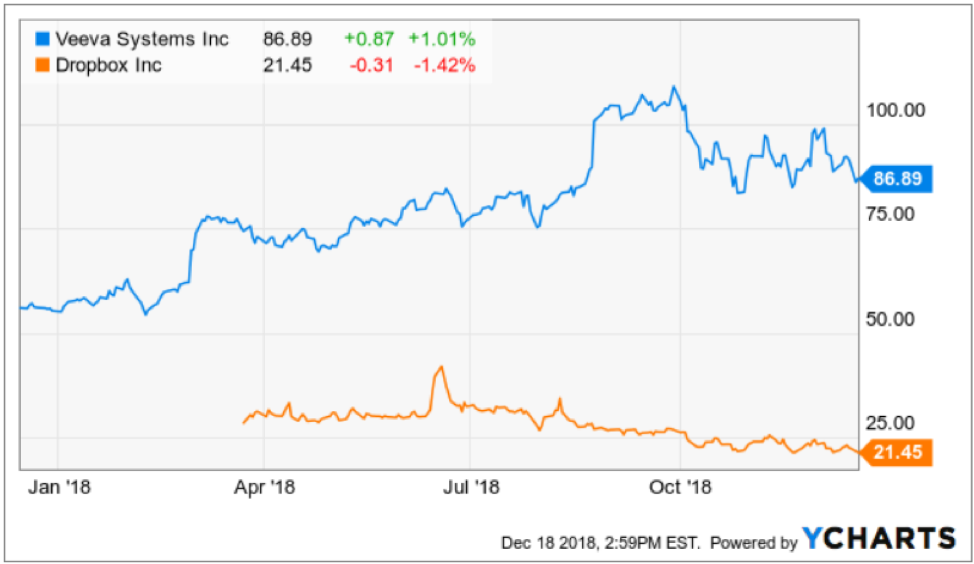
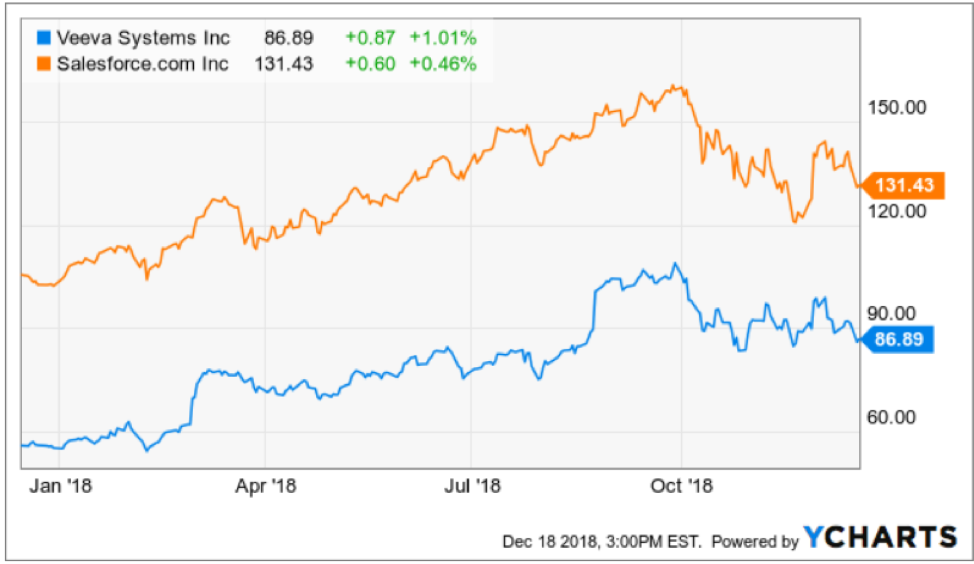
Legal Disclaimer
There is a very high degree of risk involved in trading. Past results are not indicative of future returns. MadHedgeFundTrader.com and all individuals affiliated with this site assume no responsibilities for your trading and investment results. The indicators, strategies, columns, articles and all other features are for educational purposes only and should not be construed as investment advice. Information for futures trading observations are obtained from sources believed to be reliable, but we do not warrant its completeness or accuracy, or warrant any results from the use of the information. Your use of the trading observations is entirely at your own risk and it is your sole responsibility to evaluate the accuracy, completeness and usefulness of the information. You must assess the risk of any trade with your broker and make your own independent decisions regarding any securities mentioned herein. Affiliates of MadHedgeFundTrader.com may have a position or effect transactions in the securities described herein (or options thereon) and/or otherwise employ trading strategies that may be consistent or inconsistent with the provided strategies.
This site uses cookies. By continuing to browse the site, you are agreeing to our use of cookies.
OKLearn moreWe may request cookies to be set on your device. We use cookies to let us know when you visit our websites, how you interact with us, to enrich your user experience, and to customize your relationship with our website.
Click on the different category headings to find out more. You can also change some of your preferences. Note that blocking some types of cookies may impact your experience on our websites and the services we are able to offer.
These cookies are strictly necessary to provide you with services available through our website and to use some of its features.
Because these cookies are strictly necessary to deliver the website, refuseing them will have impact how our site functions. You always can block or delete cookies by changing your browser settings and force blocking all cookies on this website. But this will always prompt you to accept/refuse cookies when revisiting our site.
We fully respect if you want to refuse cookies but to avoid asking you again and again kindly allow us to store a cookie for that. You are free to opt out any time or opt in for other cookies to get a better experience. If you refuse cookies we will remove all set cookies in our domain.
We provide you with a list of stored cookies on your computer in our domain so you can check what we stored. Due to security reasons we are not able to show or modify cookies from other domains. You can check these in your browser security settings.
These cookies collect information that is used either in aggregate form to help us understand how our website is being used or how effective our marketing campaigns are, or to help us customize our website and application for you in order to enhance your experience.
If you do not want that we track your visist to our site you can disable tracking in your browser here:
We also use different external services like Google Webfonts, Google Maps, and external Video providers. Since these providers may collect personal data like your IP address we allow you to block them here. Please be aware that this might heavily reduce the functionality and appearance of our site. Changes will take effect once you reload the page.
Google Webfont Settings:
Google Map Settings:
Vimeo and Youtube video embeds:
